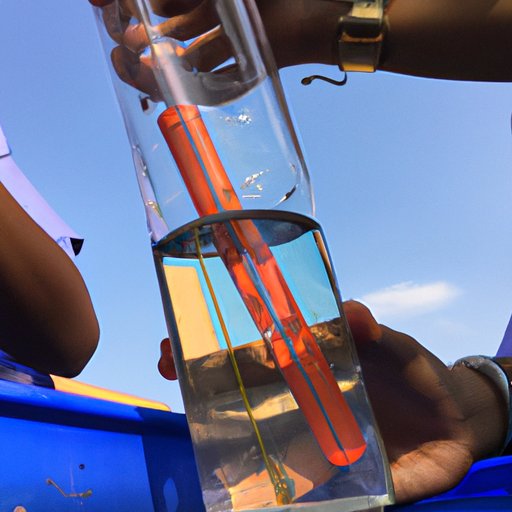Introduction
Have you ever wondered why some objects float in water while others sink? Or why it’s easier to stay afloat in the ocean than in a lake? This article will explore the answers to these questions through a hands-on science project that examines how salinity affects the buoyancy of objects in different bodies of water. By the end of this article, readers should have a better understanding of how saltwater and freshwater behave differently and how to conduct their own experiments on buoyancy.
How Does Salinity Affect the Buoyancy of Objects? A Science Experiment Exploring Saltwater vs. Freshwater
Buoyancy is the ability of an object to float in a liquid. The force that allows us to float in water is known as Archimedes’ Principle which states that “the upward force on an object in a fluid is equal to the weight of the fluid displaced by the object” (Ley & Heald, 2018). This means that when an object is placed in a liquid, it will displace an amount of liquid equal to its own weight. If the displaced liquid weighs more than the object, then the object will float. If the displaced liquid weighs less than the object, then the object will sink.
Salinity is the measure of the amount of dissolved salts in a body of water. The most common salt found in seawater is sodium chloride (NaCl), but other salts can be present in smaller amounts. Seawater has a much higher salinity than freshwater due to the presence of these dissolved salts. The higher salt content makes the density of seawater greater than that of freshwater, which means that objects are more likely to float in seawater than in freshwater (National Oceanic and Atmospheric Administration, 2021).
Exploring the Effects of Salinity on Buoyancy: A Hands-on Science Project
This science project will help students explore the effects of salinity on buoyancy. Students will need two containers filled with water, one with freshwater and one with saltwater. They will also need some objects of different shapes and sizes such as coins, rocks, corks, and other items they can find around the house. The goal of the experiment is to observe which objects float better in saltwater and which float better in freshwater.
To begin the experiment, fill each container with water and add a teaspoon of salt to one of them. Stir the saltwater until it is completely mixed. Then drop the objects into each container one at a time. Observe which ones float in the saltwater and which ones float in the freshwater. Record your observations in a chart or table. After completing the experiment, compare the results from the saltwater and freshwater containers.
Float or Sink? A Science Experiment Investigating Buoyancy in Saltwater and Freshwater
This experiment can be used to further explore the effects of salinity on buoyancy. Fill two containers with water and add a tablespoon of salt to one of them. Place the same objects as before into each container and observe which ones float in the saltwater and which ones float in the freshwater. Compare the results to the previous experiment and discuss any differences. This experiment can also be repeated with different concentrations of saltwater to observe how the buoyancy of objects changes with increasing salinity.
Put it to the Test: A Science Experiment Comparing Floating Objects in Saltwater and Freshwater
This experiment can be used to test the effects of salinity on buoyancy. Fill two containers with water and add a tablespoon of salt to one of them. Place the same objects as before into each container and observe which ones float in the saltwater and which ones float in the freshwater. Measure the time it takes for each object to float in each type of water and record the results. Discuss any differences between the saltwater and freshwater results.
Sinking or Swimming? A Science Experiment Examining Buoyancy in Saltwater and Freshwater
This experiment can be used to investigate the effects of salinity on buoyancy. Fill two containers with water and add a tablespoon of salt to one of them. Place the same objects as before into each container and observe which ones float in the saltwater and which ones float in the freshwater. Measure the depth at which each object floats and record the results. Discuss any differences between the saltwater and freshwater results.
Conclusion
In this article, we explored the effects of salinity on the buoyancy of objects through a series of science experiments. We discussed the differences between saltwater and freshwater, outlined the steps for conducting the experiments, and discussed the materials needed for the experiment. Through these experiments, we were able to observe that objects float better in saltwater than in freshwater. This is due to the higher salinity of saltwater which increases the density of the liquid and therefore increases the buoyancy of the objects. We hope that this article has encouraged readers to explore the wonders of buoyancy for themselves and to learn more about the fascinating properties of saltwater and freshwater.
(Note: Is this article not meeting your expectations? Do you have knowledge or insights to share? Unlock new opportunities and expand your reach by joining our authors team. Click Registration to join us and share your expertise with our readers.)
